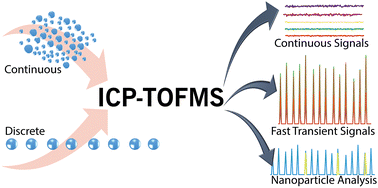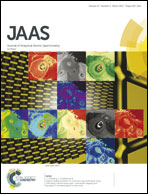Characterization of a new ICP-TOFMS instrument with continuous and discrete introduction of solutions†
Abstract
In this work, we evaluate the capabilities of a new commercially available inductively coupled plasma time-of-flight mass spectrometry (ICP-TOFMS) instrument, the icpTOF (TOFWERK AG, Thun, Switzerland), for analysis of liquid samples with a standard pneumatic nebulizer – cyclonic spray chamber sample-introduction system and a microdroplet sample-introduction system. The ICP-TOFMS instrument provides simultaneous, high-speed detection across almost the entire elemental mass range, from around 7–275 amu. The instrument provides a standard mass resolving power (Rm) of ∼2500 and can provide Rm greater than 4000 through the use of collisional cooling prior to the TOF mass analyzer. In standard operation mode (without collision gas), a sensitivity of 60 000 cps ppb−1 is routinely achieved for heavy elements such as U, with two orders of magnitude decrease in sensitivity from high-to-low masses. Limits of detection (LODs) are in the low parts-per-trillion to high parts-per-quadrillion. The data acquisition system of the TOFMS instrument provides a linear dynamic range greater than 106. The native abundance sensitivity of the ICP-TOFMS is 6.5 × 10−4 on an adjacent mass and is characterized by a non-linear sloping baseline beyond the adjacent mass channel. To obtain simultaneous high-dynamic-range detection, post-acquisition peak fitting and baseline subtraction can be used to reduce the effect of peak tailing on adjacent masses. Simultaneous quantification of adjacent isotopes across six orders of magnitude of signal intensity is possible after baseline subtraction. Advantages of ICP-TOFMS are apparent for high-speed transient analysis. Here, we assess the performance of the icpTOF for the multi-elemental analysis of single microdroplets, with specific emphasis on the characteristics of this approach for 100% transport of liquid samples and for the analysis of nanoparticles. Absolute limits of detection are in the attogram range for single droplets and concentration LODs for the detection of ensembles of droplets are competitive with those attained with pneumatic nebulization sample introduction.

- This article is part of the themed collections: JAAS Recent HOT articles and JAAS 2017 Most Downloaded Articles


 Please wait while we load your content...
Please wait while we load your content...